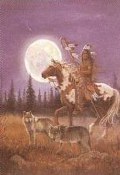 Wolves WolvesWolf History, Conservation, Ecology and Behavior
[www.wolfology.com]
|
Wolfdogs of the Plains
Jason Manning
|
There has been much debate regarding the origins of the domestic dog in North America. The general consensus is that the dog arrived on this continent approximately 10,000 years ago in the company of nomads. The earliest archaeological record of the dog in North America comes from digs at the Agate Basin in Wyoming, where part of a skull was dated back about 10,500 years ago. Another, similarly dated specimen was found at Idaho's Jaguar Cave. (It is interesting to note that the earliest recorded domestic dog specimen was found in Iraq and dated prior to 12,000 years ago. This is in keeping with the theory that the first domestication of wolves occurred in northern Africa; those wolves are the direct descendants of the species currently found in Ethiopia and Iran.) Other North American sites where specimens were found include Wyoming's Horner site (dated 8,800 years ago), Missouri's Rodgers Shelter (7,500 years ago), and the Koster site in Illinois (dated 7,000 years ago.) Generally, these specimens were small- to medium-sized canids easily distinguishable from the present North American species, Canis lupus.
Early explorers made note of the wolf-like appearance of the Amerind dogs. Audubon remarked that he "looked at the Indian Dogs again with much attention, and was assured that there is much cross breeding between these dogs and wolves, and that all the varieties actually come from the same root." Maximilian noted that "in shape they differ very little from the wolf, and are equally strong. . . . [T]hey partially descend from wolves, which approach the Indian huts, even in daytime, and mix with the dogs."
Eskimos commonly removed the canine and incisor teeth of their domesticated dogs by striking the teeth with a hammer and grinding down the rough edges. This was done, in part, to keep the dogs from chewing the tethering lines of the sleds to which they were often hitched. But it was also done for personal protection, because the dogs were large and powerful animals that were, essentially, wolves that had lost their fear of man.
In the third part of their extensive study of Amerind dogs -- Prehistoric Wolf/Dog Hybrids From the Northwestern Plains (London: Academic Press, 1982) -- Danny N. Walker and George C. Frison concluded after studying various analyses of the prehistoric specimens mentioned above that the Wyoming specimens represented an "intermediary group between the large Eskimo dogs . . . and wolves" and therefore proposed that "the Wyoming prehistoric canid population represents hybrids between wolves and aboriginal North American large dogs during the Late Prehistoric period." The domestic dogs brought to this continent by nomads interbred with various subspecies of the American gray wolf as they spread to the east and south, as indicated by early accounts of large wolf-like canids in Nebraska and the Dakotas. The constant infusion of wolf genes "into the hybrid population [prevented] a pure breeding of the hybrids during succeeding generations," say Walker and Frison, with the result that "such backcrosses would appear more and more wolf-like."
The analysis upon which Walker and Frison based their findings focused primarily on differences in cranial and mandibular ratios between modern wolves and dogs and the prehistoric Amerind dog specimens. One example was a comparison of the tympanic bullae. While the bullae of modern dogs are small- or medium-sized, strongly compressed or slightly crumpled, wolves exhibited large, convex and spherical bullae. Those of the prehistoric specimens, on the other hand, reflected elements of both wolf and dog. But the most telling criterion proved to be the orbital angle -- the angle formed between the orbital plane and the forehead plane. Domestic dogs differ markedly from wolves with respect to the orbital angle. The Wyoming prehistoric specimens showed a clear overlap between dog and wolf, while trending toward the wolf.
|
Copyright 2002 Jason Manning All Rights Reserved
Feel free to duplicate for educational purposes.
|
